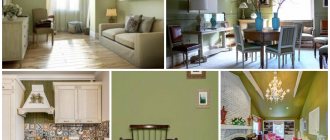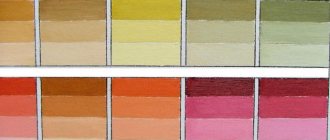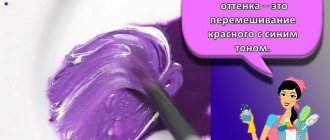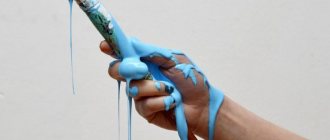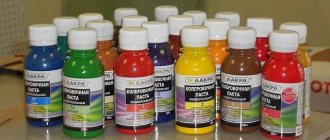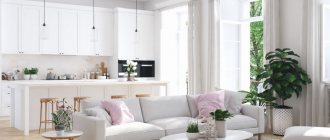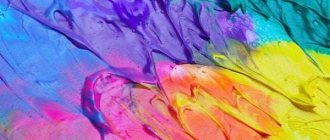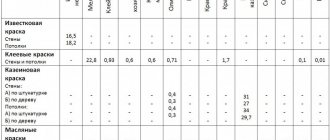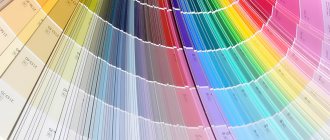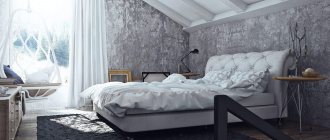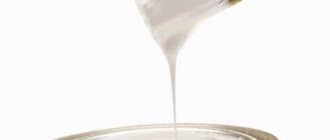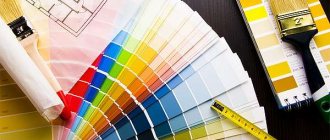Mixing colors is one of the most difficult procedures that a person who decides to make repairs on their own may face the need to perform. The point is that it is very important to know what colors to mix to create a certain tone. It should be immediately noted that it is better to purchase white paint and tint it in a store using a special machine, so the tone will be uniform. If you decide to do everything yourself, then you can read more about how to mix colors correctly.
Variety of colors
There are two types of colors on sale, with different consistencies. The first type of colors is very thick in consistency and resembles a paste. When added to a white base, you will get the most dense, intense and vibrant color.
The second type of colors is thinner in consistency and very intense. When you mix an intense color with a white base, you get a muted pastel color.
Intensive colors are increasingly being used, this is due to the fact that manufacturers present a wide range of color palettes for paints, with different areas of application, suitable for covering various surfaces.
Colors are produced to cover various surfaces, this significantly improves the result. On store shelves you can find colors for:
- Colors for coating wooden surfaces
- Colors for water-based paints
- Colors for enamels
- Colors for varnishes with a translucent consistency; using it you can achieve silver, gold, pearl and copper shades.
Manufacturers produce base and color in tandem. Builders use the base and colors of the same company in their work. This solution significantly reduces the risks of obtaining poor-quality coating.
When mixing base and color from different companies, there is a possibility of the composition collapsing. After applying a composition of different colors and bases, after drying, it is possible that the paint will crack and then crumble. It is better to use components from one company.
There are two types of enamel tinting:
scientific It is mainly used for painting small volumes of product surfaces. In addition, it is also applicable in such works as renovation of premises, etc. The main advantage of the manual method is the ability to create colors according to your own taste and color perception. In addition, it does not require large financial costs and can be carried out indoors. However, manual tinting of enamel also has its drawbacks. And first of all, it is still impossible to obtain a high-quality color range, and mixing occurs unevenly.
Tinting using special equipment (automatic). This process is possible through the use of appropriate technology and software. This way you get a wide range of color palettes in large production volumes. The enamel is tinted quickly and efficiently; all the necessary components are mixed in special equipment. You just need to select the desired color or shade, set the program, and a modern device will do the rest for you.
Application of color
Using color is not as simple as it seems at first glance. A novice builder and amateur needs to know that color consumption per 1 kg of paint is indicated as a percentage. With increasing base weight, the percentage of color does not change.
How to dilute paint colors is more easily presented in percentage terms.
- The percentage of color in oil paint should not exceed 15%.
- The percentage of color in water-based paints should not exceed 20%.
- The percentage of color in other base compositions should not exceed 7%.
When using a thick paste color, even with a slight decrease in the percentage of the base, the color will turn out bright and saturated.
The use of liquid intensive color will not give a rich color when using water-based paint. The color will be a muted pastel. When choosing a color consistency, it is important to take this factor into account.
Not only colors for paints intended for room design are appearing on sale, but also for facade work. The color improves the paint's resistance to various external factors, ultraviolet radiation and various natural precipitation.
Not all colors have been developed that are suitable for use in medical and educational institutions.
There is no clear answer as to which color is best to use. It all depends on the scope of application. Thick color paste is a little more difficult to use. It must be introduced into the base in parts to achieve a certain color.
Ready-made compositions with colors are available for sale, which can be studied using the atlas. Simply add them to the white base, mix thoroughly, and the paint is ready for use.
Ceresit palette
Are you wondering how the Ceresit tinting process works?
Advantages of tinted paints for facades:
- the service life of the coating increases;
- increased levels of abrasion and fading;
- the coating attracts with the brightness of the shade;
- large selection of pigment colors..
Who is a light façade suitable for?
Elegant, classic tones with low or medium brightness levels create lightness. The colors of the groups FOREST and EARTH create a feeling of peace and relaxation. Ideal for country houses, cottages and recreation centers.
It is better to take a lighter tone after construction, and then change something later, choosing more saturated tones from the same palette. A base that is too dark is difficult to paint over later. Unsaturated, soft tones form a light and weightless design.
They can be complemented by more cheerful bright shades of the Nature palette: SAND, WATER and EARTH . Reds and oranges bring joy and energy, while blues and grays convey class and professionalism.
Multicolor facades
A bright style is difficult to make harmonious. We will be happy to help you choose colors so that it looks beautiful. The main thing is to choose 2-3 colors, with one being the background.
The color of the building can contrast with the surrounding panorama - a peculiar accent gives the appearance of the house a complete look. VODA group creates a youthful style, charged with energy and freshness. This group of colors is the brightest.
Urban forms are rich in green and brown tones of the Nature palette: SAND and FOREST . The house “dissolves” against the backdrop of the forest or among the thickets of the garden.
Attention! According to the coloring rules, the foundation or base should be darker. The color of the white façade roof should not blend in with the main tone. Usually it is darker, but a lot depends on the material and style of the building.
Specificity of pigments
Pigments according to their composition are divided into organic and inorganic. The use of an organic dye allows you to uniformly color the base without bald spots, but there are also disadvantages; organic dyes are extremely unstable to sunlight.
This coating is not durable and requires constant updating due to color fading.
- An inorganic color for acrylic paint does not fade when exposed to sunlight, but is significantly inferior in pigmentation to organic colors.
- It is best to use colors that contain both organic and inorganic dyes.
Traditional color wheel
Experts call blue, red, and yellow the “three pillars” of color and painting. It is on them that the widest palette of halftones of the second and third orders rests; they are combined with each other, while creation by mixing paints is excluded.
All the most important colors are included in the so-called color wheel. It represents a conditional model divided into sectors. The latter are placed in an order close to their location in the visible light spectrum. The adjacent shades are called chromatic; they can be mixed together to obtain a new chromatic (color) paint. If, when mixing paints, you take opposite tones, the result will be an achromatic color (grayish). That is, the further the colors are from each other, the more likely it is that their mixture will give an inexpressive, ugly tone.
Using color
There are two ways to mix colors with a white base: manually and using a program. The first option is more suitable for mixing a small amount of paint.
You can mix the paint anywhere; the color is introduced into the base in portions to achieve the desired shade.
- In order to color a large amount of base, it is better to use a program coloring method, since when mixing manually, the shades will differ from the initial one, and it is impossible to achieve a uniform color.
- Programmatic coloring of the base allows you to achieve one tone with several colors. The program calculates the use of color and white base exactly to 1 gram. This way the color is identical, bright, and saturated.
- It is not advisable to purchase a computer system with hardware for home use.
To color a white base by hand, it is better to use an intense, liquid color. For program coloring it is better to use a thick color paste.
The advent of colors made a huge breakthrough in the field of design. The use of colors allows builders and designers to bring a wide variety of design solutions to life.
To do this, you don’t need to look for ready-made paint with the most suitable color. You can make the required color yourself.
What do you need to know before you start lightening your hair after dyeing?
Dyed hair, especially dark hair, is difficult to bleach. This procedure causes significant harm to the curls.
Therefore, lightening manipulations should be carried out with the utmost care. In order for the lightening process to be more effective, and for the hair to suffer less from this, it is necessary to create comfortable conditions for it:
- use only sulfate-free hair cosmetics;
- minimize the application of all types of styling;
- If possible, avoid using a hair dryer, straightening iron, or curling iron;
- do not use cosmetics designed to preserve color;
- use care products with the addition of natural ingredients (masks, balms).
Photo of paint colors
Gouache
Gouache is a paint that is great for beginners. One of its main features is the high proportion of pigment and filler contained in the composition. As a result, the substance is completely opaque.
Paint Features
The color produced by gouache is stronger than watercolor. The applied layer of gouache dries quickly on the surface, after which it becomes slightly lighter. And artists must take this property of this type of paint into account.
Mixing Techniques
You can mix colors when working with gouache using one of the techniques presented in the table:
| Way | Description |
| Mechanical | The colors are simply mixed on the palette |
| Optic | A new layer is applied to the already dry paint. The main thing is that the 2nd layer, which will be located above, is transparent or translucent. |
| Spatial | This is essentially one of the varieties of the optical method. In the color wheel, colors that complement each other are located at opposite ends of its diameter. When a pair of non-complementary chromatic colors is optically mixed, a new tone is formed. In the color wheel, this tone will always be located between the 2 colors being mixed. The resulting colors will be less saturated than those that were mixed. The greater the distance between them on the color wheel, the less saturated the mixture. |
